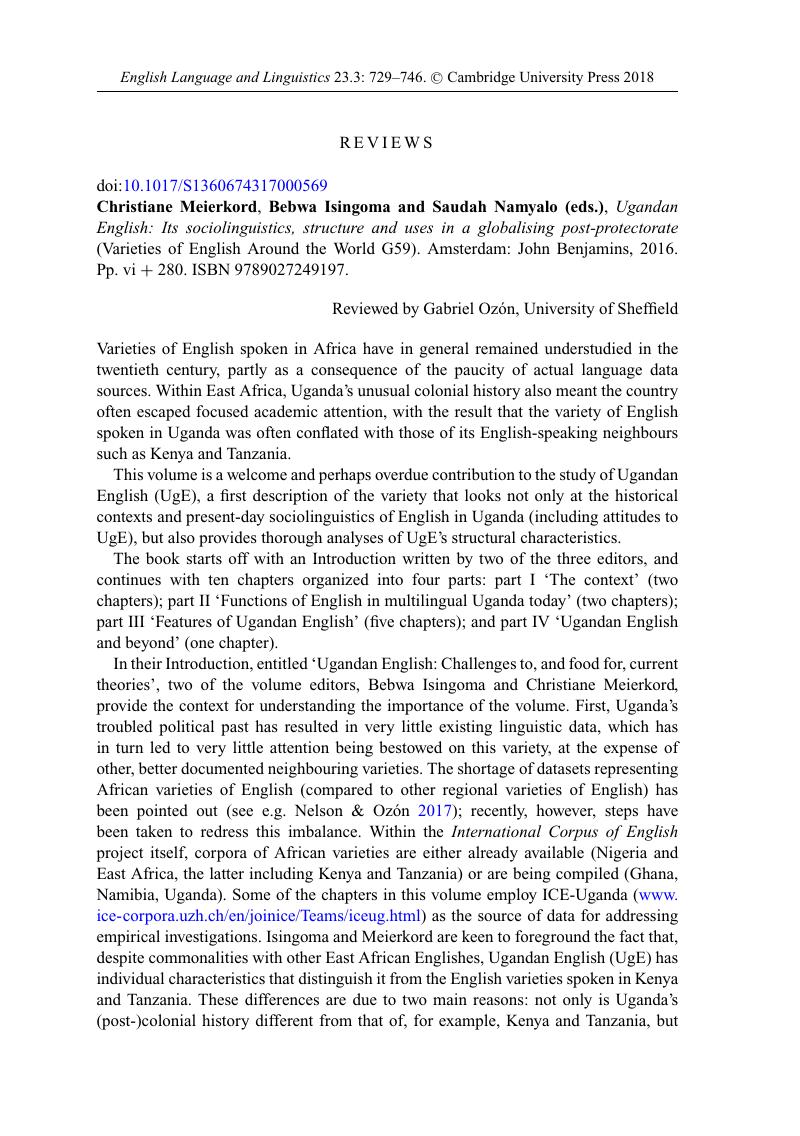No CrossRef data available.
Article contents
Christiane Meierkord, Bebwa Isingoma and Saudah Namyalo (eds.), Ugandan English: Its sociolinguistics, structure and uses in a globalising post-protectorate (Varieties of English Around the World G59). Amsterdam: John Benjamins, 2016. Pp. vi + 280. ISBN 9789027249197.
Review products
Christiane Meierkord, Bebwa Isingoma and Saudah Namyalo (eds.), Ugandan English: Its sociolinguistics, structure and uses in a globalising post-protectorate (Varieties of English Around the World G59). Amsterdam: John Benjamins, 2016. Pp. vi + 280. ISBN 9789027249197.
Published online by Cambridge University Press: 03 January 2018
Abstract
An abstract is not available for this content so a preview has been provided. Please use the Get access link above for information on how to access this content.

- Type
- Book Review
- Information
- Copyright
- Copyright © Cambridge University Press 2018
References
Mair, Christian. 2013. The world system of Englishes: Accounting for the transnational importance of mobile and mediated vernaculars. English World-Wide 34 (3), 253–78.Google Scholar
Meierkord, Christiane. 2012. Interaction across Englishes: Linguistic choices in local and international contact situations. Cambridge: Cambridge University Press.Google Scholar
Michaelis, Susanne. 2014. Loan valency patterns in creoles: Evidence from the Atlas of Pidgin and Creole Language Structures (APiCS). Presented at the 47th Annual Meeting of the Societas Linguistica Europaea, Adam Mickiewicz University, Poznań, Poland.Google Scholar
Mufwene, Salikoko S. 2001. The ecology of language evolution. Cambridge: Cambridge University Press.Google Scholar
Mukherjee, Joybrato & Hoffmann, Sebastian 2006. Describing verb complementation profiles of New Englishes: A pilot study of Indian English. English World-Wide 27 (2), 147–73.Google Scholar
Mukherjee, Joybrato & Hundt, Marianne (eds.). 2011. Exploring second-language varieties of English and learner Englishes: Bridging a paradigm gap. Amsterdam: John Benjamins.Google Scholar
Mukherjee, Joybrato & Schilk, Marco 2008. Verb-complementational profiles across varieties of English. Comparing verb classes in Indian English and British English. In Navalainen, Terttu, Taavitsainen, Irma, Pahta, Päivi & Korhonen, Minna (eds.), The dynamic of linguistic variation: Corpus evidence on English past and present (Studies in Language Variation 2), 164–81. Amsterdam: John Benjamins.Google Scholar
Nelson, Gerald & Ozón, Gabriel. 2017. World Englishes and corpus linguistics. In Low, Ee Ling & Pakir, Anne (eds.), World Englishes: Re-thinking paradigms, 149–64. London: Routledge.Google Scholar
Schneider, Edgar. 2003. The dynamics of New Englishes: From identity construction to dialect birth. Language 79 (2), 233–81.Google Scholar
Seoane, Elena. 2016. World Englishes today. In Seoane, Elena & Suárez-Gómez, Cristina (eds.), World Englishes: New theoretical and methodological considerations (Varieties of English around the World G57), 1–16. Amsterdam: John Benjamins.Google Scholar




